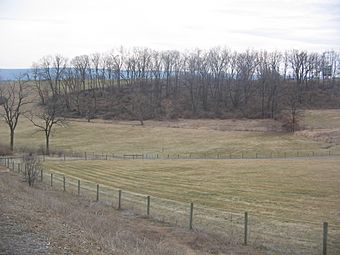Tudek Site facts for kids
Quick facts for kids |
|
|
Tudek Site
|
|
 |
|
| Location | Along Orchard Rd., northeast of State College College Township, Centre County, Pennsylvania |
|---|---|
| Nearest city | State College, Pennsylvania, USA |
| Area | 14.8 acres (6.0 ha) |
| NRHP reference No. | 82003778 |
| Added to NRHP | February 12, 1982 |
The Tudek Site is a special place in Pennsylvania, United States. It's an archaeological site, which means it's where scientists study old things to learn about the past. Long, long ago, about 10,000 years ago, Native Americans used this spot like a rock quarry to get stones. Today, it's important to protect this site so we can keep learning from it.
Contents
Where is the Tudek Site?
The Tudek Site is in College Township, near a community called Houserville. You can find it on rolling hills along Orchard Road.
A long time ago, before European settlers came, this area was covered in thick hardwood forests. But since the 1800s, people have used the land for farming. Recently, more buildings have been built around Houserville, and there's less farming happening.
How Was the Tudek Site Discovered?
Finding the Site
In 1978, experts from Pennsylvania State University looked for old sites along a stream called Slab Cabin Run. They found many places, including the Tudek Site. It was named after Bob Tudek, a student who first found it.
Close by is another important place called the Houserville Site. The stones found at Houserville were actually dug up from the Tudek Site.
Digging for Clues
In May 1980, archaeologists started digging at the Tudek Site. They knew a new highway might be built there, so they wanted to study it quickly. They found many types of a special stone called "Bald Eagle Jasper."
Two months later, a bigger dig began. They found a huge number of old objects, about 350 artifacts in every cubic meter of dirt!
What We Learned from the Dig
The Tudek Site is very old, dating back to the Early and Middle Archaic periods. This means it was used between 8,000 and 3,500 BC. No specific projectile points or stone tools were found at Tudek to help with dating. However, similar tools were found at the Houserville Site, which helped scientists figure out when both sites were used.
Scientists believe that Native Americans mined the yellow Bald Eagle Jasper at Tudek. They might have heated the stone there too. Then, they carried it about 1.5 kilometers (about 1 mile) east to the Houserville Site.
What Do the Sites Tell Us?
Life at the Quarry
After studying both Tudek and Houserville, scientists think that groups of people visited these sites for short times. Their main goal was to get and prepare the Bald Eagle Jasper.
The Tudek and Houserville sites were used for different things. At Houserville, many tools and stone flakes were found. But at Tudek, these kinds of objects were mostly missing. This suggests that the Archaic people only stayed at Tudek long enough to dig up the jasper. Then, they would go back to their camps at Houserville. Very little stone shaping happened at Tudek. They mostly just made rough stone blocks, ready to be shaped somewhere else.
Understanding Ancient Trade and Tools
Archaeologists from Pennsylvania State University say that what they learned from the Tudek Site is super important. It helps us understand the Archaic period in central Pennsylvania.
Objects made from Bald Eagle Jasper have been found in many places around the region. Knowing where this stone came from can help us understand ancient trade routes. Also, studying these sites helps archaeologists learn why later cultures stopped using Bald Eagle Jasper.
Finally, changes in how Native Americans made tools often came with changes in their society. The evidence from the Houserville Site can help us understand how Early and Middle Archaic societies grew in central Pennsylvania.
Protecting These Special Places
In 1982, the Tudek Site was added to the National Register of Historic Places. This was because of its great value for archaeology. Four years later, the Houserville Site also got this important status.



